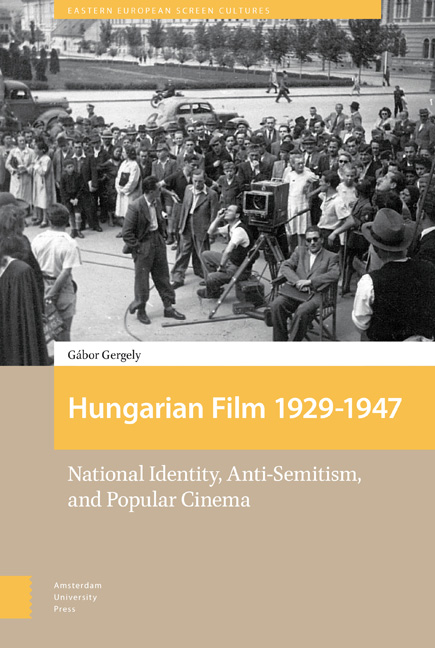Book contents
- Frontmatter
- Dedication
- Contents
- List of Illustrations
- Acknowledgements
- A Note on Accents, Pronunciation, Names, and Spellings
- Preface
- Introduction
- 1 Key Concepts in Pre-1945 Hungarian Cinema
- 2 A Contested Film History
- 3 An Industry Emerges 1931-1935
- 4 Boom, Crisis and Anti-Semitic Reorganization 1936-1941
- 5 From War Boom to Bust 1941-1944
- Epilogue: Industry Reboot and the Myth of a New Start 1945-1947
- Concluding Remarks
- Bibliography
- Index
- Frontmatter
- Dedication
- Contents
- List of Illustrations
- Acknowledgements
- A Note on Accents, Pronunciation, Names, and Spellings
- Preface
- Introduction
- 1 Key Concepts in Pre-1945 Hungarian Cinema
- 2 A Contested Film History
- 3 An Industry Emerges 1931-1935
- 4 Boom, Crisis and Anti-Semitic Reorganization 1936-1941
- 5 From War Boom to Bust 1941-1944
- Epilogue: Industry Reboot and the Myth of a New Start 1945-1947
- Concluding Remarks
- Bibliography
- Index
Summary
This book has shown that Hungarian films reflected a national obsession with Trianon, the restoration of territorial integrity, and miraculous resolutions to seemingly insurmountable problems. The films of the period articulated a concept of the nation that pointed to widespread anti-Semitism by engaging in a discourse built on the opposition of the desirable Hungarian ideal with undesirable ‘Jewish’ traits. Before anti-Jewish legislation imposed an ever greater degree of uniformity on the sector, films had already iterated this concept of a nation that excluded the Jewish other by denying Jewish Hungarians’ ability to integrate into a society of which they were, in truth, an organic part and rejecting their right to success, dignity, and, ultimately, participation. As successive national governments applied ever greater pressure on the sector to rid itself of ‘Jewish’ influence, the sector underwent a profound transformation as film entrepreneurs, artists, and technicians were replaced by a different cohort of entrepreneurs, artists, and technicians. Despite this profound transformation, crucial constancies were observed as the putatively new ‘racially pure’ Hungarian film sector continued to iterate relatively unchanged concepts of the Hungarian nation and the national ideal. Film businesses fell into line and participated in the assertion of state control. Without their acquiescence and the active participation and strong support from a small set of key industry personnel, the state would have struggled to impose its will fully on the industry. Hungarian filmmakers did not seek alternative avenues for production with the only exception of Klára Riedl's In the Palmof God, an ethnographic docu-drama shot over five years on location in Mezőkövesd. Eventually that film, like the entire sector, was taken over by the radical right and repositioned as a paean to the countryside (see: Gergely 2016c). The films produced by a sector entirely in thrall to the state reaffirmed the vision of the nation preferred by the state, which, in turn, iterated and thereby produced a nation that was anti-Semitic, nationalistic, accepting of the inequalities of a state that practised paternalism towards some and repression towards others. As a result of the ever growing control of the state over the film sector, audiences found an ever greater proportion of their fare made up of domestic productions reflecting, articulating, iterating, and performing the state's radical nationalist vision of the nation.
- Type
- Chapter
- Information
- Hungarian Film, 1929–1947National Identity, Anti-Semitism and Popular Cinema, pp. 313 - 318Publisher: Amsterdam University PressPrint publication year: 2017



